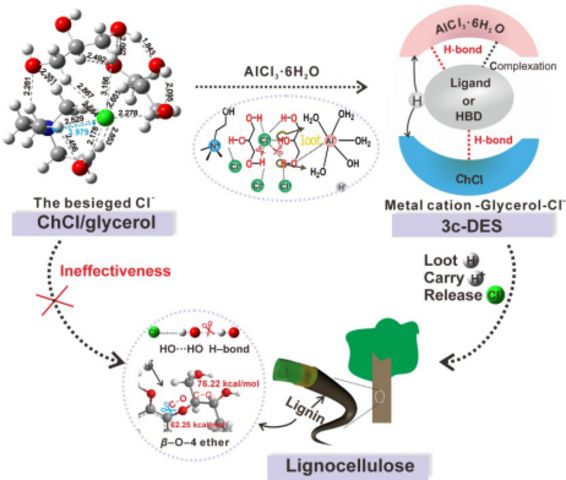Recently, the internationally renowned journalGreen Chemistrypublished online the latest research achievement of Professor Yu Haipeng and his research team,Multiple Hydrogen Bond Coordination in Three-constituentDeep Eutectic Solvent Enhances Lignin Fractionation from Biomass,of the Materials Science and Engineering College (Key Laboratory of Biomass Materials Science and Technology of the Ministry of Education). The paper is centered on the green and efficient refining strategy of biomass resources, and explores the physicochemical structure mechanism of a solvent system and biomass depolymerization in response to the “disaggregation barrier” formed by multi-scale structures and complex components of forest trees. In addition, taking the eutectic solvent (DES) with hydrogen-bonding associating properties effectively breaking down the “lignin-carbohydrate complex (LCC)” as the entry point, the paper proposes the concept of hydrogen acceptance at multiple sites and has designed an ternary DES system for the efficient separation of lignin.
The first author Xia Qinqin, a 2017 doctoral student, studied the use of choline chloride and glycerol, and explored the use of density functional theory (DFT) and Kamlet-Taft solvatochromic parameters to explore the molecular geometry, electronic structure, hydrogen bonding type and strength, hydrogen bonding acidity, and acceptor capability of choline chloride and C Triol. She found that anion hydrogen bonding and cationic hydrogen bonding in choline chloride/glycerol DES caused the "siege" of the hydrogen trapping site, resulting in a weakened hydrogen abstraction capability. The reduced delocalization of the solvent hydrogen atom, the weakened hydrogen bond acidity (α=0.77), and the lack of effective active hydrogen protons and acid sites resulted in the inability of the system to effectively crack the LCC structure and dissolve the lignin. Based on the above analysis, she proposed the use of Lewis acidity and multi-site characteristics of AlCl3•6H2O to rescue the “besieged” Cl- and construct active acid sites, which would enhance the competitiveness and intimacy of the solvent molecules for hydroxyl targets in LCC structures. The new solvent has a high hydrogen bond acidity value (1.99) and significantly improved hydrogen bond acceptability (0.68). The DFT calculation and NMR test proved that the solvent could form a strong hydrogen bond with the lignin unit structure and effectively break its internal chemical bonds, such as aryl ether bonds, and thus the separation efficiency of lignin could be increased from 3.61% to 95.46% with the purity reaching 94%. The paper shows that quantum chemical calculations can provide an in-depth analysis of the structure and solvation abilities of DES molecules and reveal the reasons for their failure during biomass treatment, thus providing solutions for improving the quality and efficiency of solvents. The new solvent system has advantages of outstanding designability, simple preparation, low cost and strong solvency, and is an excellent replacement of high-cost, high-toxicity, high-risk and non-green solvents for the efficient separation and reuse of biomass components. This strategy can also provide a theoretical reference for the design of new solvents, and stimulate the research in efficient refining and controlled conversion of biomass.
Green Chemistryis a world-famous periodical for the field of green chemistry under the British Royal Society of Chemistry. It is ranked Top in Division 1 of the Journal of the Chinese Academy of Sciences, with an impact factor of 9.125. The research was supported by the National Natural Science Foundation of China, the Heilongjiang Outstanding Young Scientists Fund, and the Central University’s Basic Scientific Research Fund.
The link of the paper: http://pubs.rsc.org/en/content/articlelanding/2018/gc/c8gc00900
